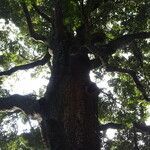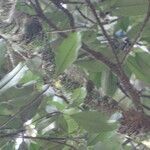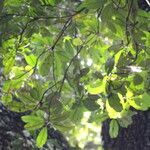Small to medium tree, height up to 30 m., with rough dark grey or blackish bark.. Terminal buds, young shoots and petioles glabrescent.. Petioles 0.5–1.7 cm. long.. Leaf-lamina oblong-elliptic to oblong-obovate, up to 9.5(–11) cm. long, 4.5(–5.3) cm. wide, apex rounded and slightly emarginate or rarely shortly acuminate, broadly to narrowly cuneate, coriaceous; upper surface deep green with reticulum of very fine veins, lower surface silvery-grey with dense indumentum of minute closely appressed regularly arranged hairs sometimes brownish on midrib and main nerves or midrib glabrescent.. Flowers axillary, usually in clusters of 4–6 in axils of current leaves.. Pedicels 3–10 mm. long, with brown pubescence.. Calyx-lobes connate near base; outer lobes ovate or ovate-oblong, 4.5–6 mm. long, 3–3.7 mm. wide, with brown pubescence externally; inner lobes slightly smaller and with less pubescence.. Corolla yellow; tube ±1.5 mm. long; lobes trifid, or entire in ♀ flowers; two outer segments ± lanceolate, up to 4 mm. long; median segment ± elliptic, up to 5 mm. long, tapering to narrow basal attachment.. Fertile stamens 6–12; filaments up to 3.5 mm. long; anthers up to 2.5 mm. long.. Staminodes truncate or subulate, ± 1 mm. long, or sometimes filament-like and then up to 3.5 mm. long, irregularly denticulate or with few long teeth.. Ovary depressed globose, pilose; style up to 4 mm. long; stigma simple or sometimes 6-papillate.. Fruit ovoid or ± ellipsoid, up to 1.3 cm. long, 0.8 cm. in diameter, puberulous when young but becoming glabrescent.. Seeds solitary or rarely two present, obliquely ovoid and slightly flattened, up to 10 mm. long, 6 mm. in diameter; hilum lateral, oblique and extending to base.. Fig. 13, p. 71.
A tree. It grows 6-18 m tall. It has a straight clean trunk 60 cm across. The bark is rough and light coloured. The young growth often has red hairs. The leaves are simple and alternate. They are crowded near the tips of branches. The leaves are green above and have silvery hairs underneath. Leaves are large and oblong. The base is narrowed. The leaves are 2.5-10 cm long by 1.3-4 cm wide. The midrib is raised below. The leaf stalks are sturdy and red. The flowers are in groups in the axils of the leaves. The flowers are yellow. The fruit are 1.3 cm across. The fruit are round and yellow turning apricot. They have a juicy pulp. The seed is oval, pale and flattened. The fruit is edible.
Leaves tending to be clustered at branch ends. Lamina 3·5–7(13) x 1·5–5 cm., elliptic–obovate to obovate, apex emarginate, acute or apiculate, base acute; petiole 6–18 mm. long. Upper leaf surface glabrous, dark green, midrib impressed, very fine reticulation visible but veins not raised or impressed. Lower surface silvery–sericeous with a dense appressed indumentum, midrib prominent, main lateral nerves faintly visible, numerous, reticulation obscured by indumentum.
Other flower forms: corolla simpler, petals entire (lateral segments absent) or trifid, or lateral segments present but united to near the apex; stamens all, or only the inner whorl, replaced by staminodes, these filament–like or represented by dentate flaps of tissue. (Flowers with a reduced androecium, i.e. less than 12 stamens, have a reduced corolla.)
Corolla equalling calyx, tube c. 1 mm. long; each petal 3–lobed, the median segment obovate, tapering to a slender basal attachment, the lateral segments elliptic.
Flowers yellow, in axillary fascicles on pedicels 3–6 mm. long. Form of flowers variable (see J. H. Hemsley, tom. cit.: 500–510, 1966); normal form as follows.
Tree 3–40 m. high; bole of larger specimens shallowly fluted near the base; slash pink; bark brown or blackish grey, longitudinally fissured.
Fruit up to 1–3 x 0–8 cm., ovoid or ellipsoid, initially puberulous, glabrescent and yellow when ripe, edible, 1 (2)–seeded.
Young stems glabrous to densely greyish–pubescent but soon glabrescent.
Stamens 12 in 2 whorls; anthers c. 1·5 mm. long.
Calyx c. 4 mm. long, sepals ovate.
Twigs with granular grey bark.
Gynoecium c. 3 mm. long.
Seeds up to 1 cm. long.
Staminodes absent.




